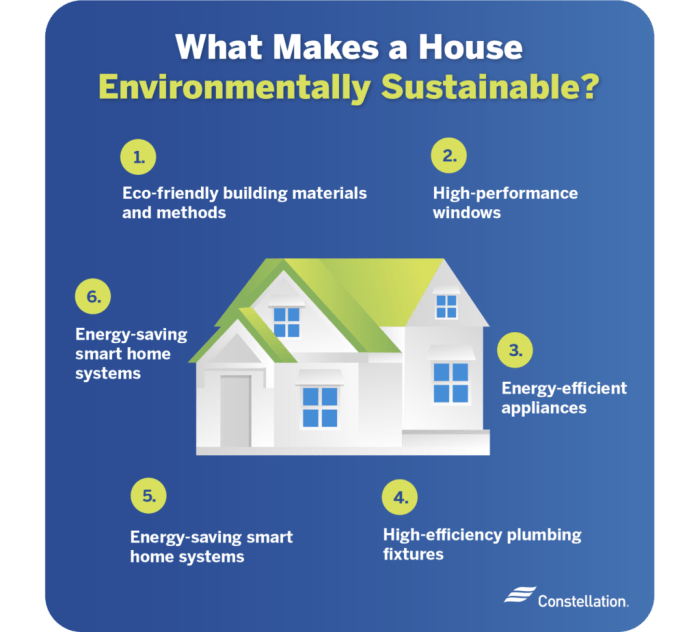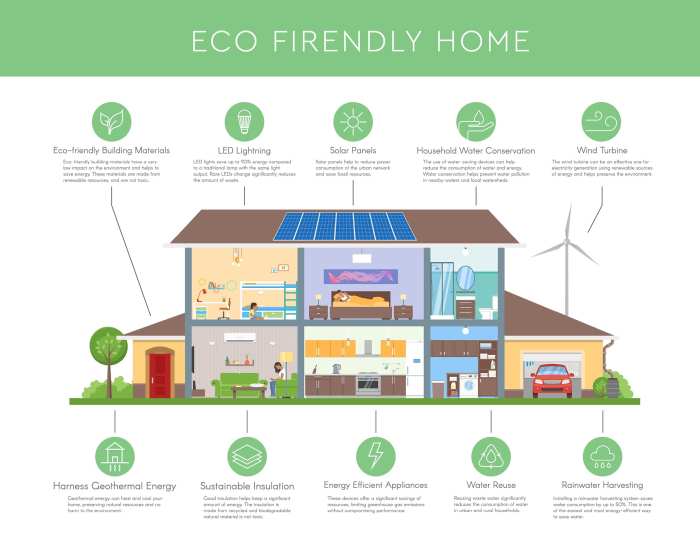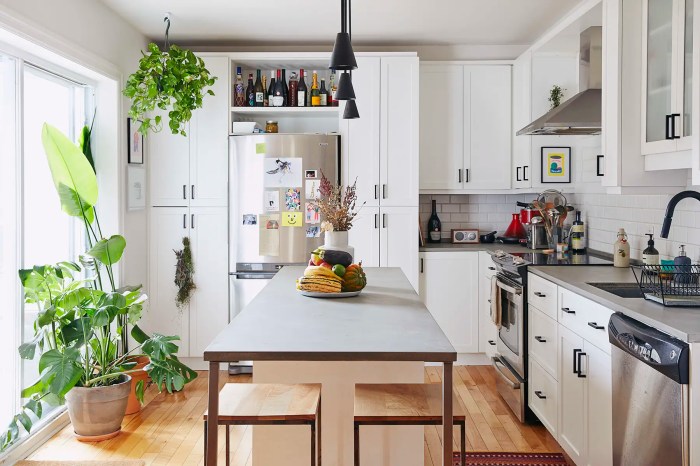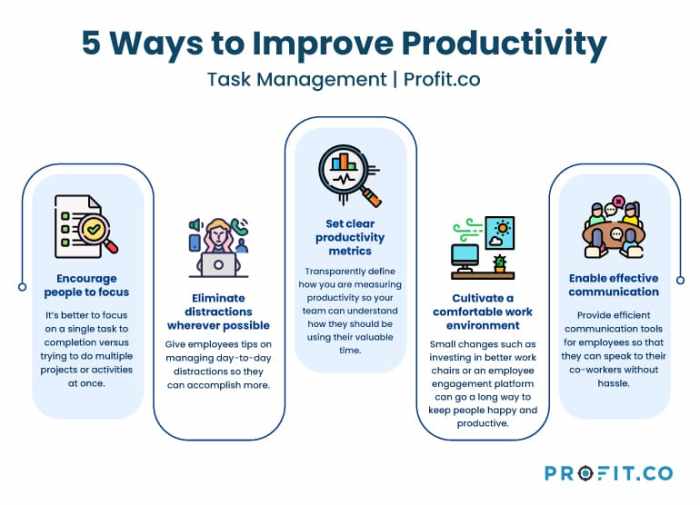
Embarking on a home improvement journey doesn’t have to be at odds with environmental consciousness. By incorporating sustainable practices, you can create a home that’s not only comfortable and stylish but also gentle on the planet. From energy efficiency to water conservation, this guide explores a range of practical tips and techniques to transform your home into a haven of eco-friendly living.
From energy-efficient appliances to water-saving fixtures, sustainable building materials to waste reduction strategies, this guide provides a comprehensive roadmap for creating a home that aligns with your values and contributes to a healthier environment.
Energy Efficiency

Energy efficiency is a crucial aspect of creating a sustainable home. By reducing your energy consumption, you can lower your utility bills, decrease your carbon footprint, and contribute to a healthier environment. There are several strategies you can implement to enhance energy efficiency in your home, from improving insulation to using energy-efficient appliances and smart home technology.
Improving Insulation
Insulation plays a vital role in preventing heat loss during winter and heat gain during summer, thus minimizing the need for heating and cooling. Here are some strategies to improve insulation in your home:* Attic Insulation: The attic is a major source of heat loss in the winter and heat gain in the summer. Adding insulation to your attic can significantly improve energy efficiency.
You can use blown-in insulation, fiberglass batts, or rigid foam boards. The recommended R-value for attic insulation varies depending on your climate zone, but a minimum of R-38 is generally recommended.
Wall Insulation
Walls also contribute to heat loss and gain. You can improve wall insulation by adding insulation to existing walls or during new construction. Blown-in insulation, fiberglass batts, and rigid foam insulation are common options.
Window Insulation
Windows are another significant source of heat loss and gain. You can improve window insulation by installing storm windows, applying window film, or replacing old windows with energy-efficient ones. Energy-efficient windows have multiple panes of glass with low-e coatings that reflect heat back into the house during winter and out of the house during summer.
Energy-Efficient Appliances and Lighting
Choosing energy-efficient appliances and lighting can significantly reduce your energy consumption and lower your utility bills. * Appliances: Look for appliances with the Energy Star label, which indicates that they meet specific energy-efficiency standards. Consider upgrading older appliances like refrigerators, dishwashers, washing machines, and dryers to newer, more energy-efficient models.
Lighting
Replace traditional incandescent light bulbs with LED or CFL bulbs. LED bulbs use significantly less energy and last much longer than traditional bulbs. You can also use smart lighting systems that automatically turn off lights when rooms are empty.
Installing Solar Panels or Wind Turbines
Solar panels and wind turbines can generate renewable energy, reducing your reliance on fossil fuels and lowering your carbon footprint.* Solar Panels: Solar panels convert sunlight into electricity. The cost of solar panels has decreased significantly in recent years, making them a more affordable option for many homeowners. Factors to consider include the amount of sunlight your roof receives, the size of your home, and your energy consumption.
Wind Turbines
Wind turbines convert wind energy into electricity. Wind turbines are best suited for areas with consistent wind speeds. The size and type of wind turbine you need will depend on your energy needs and the wind conditions in your area.
Smart Home Technology
Smart home technology can help you monitor and control your energy consumption, leading to significant energy savings. * Smart Thermostats: Smart thermostats can automatically adjust your heating and cooling systems based on your schedule and preferences. This can help you save energy by reducing the amount of time your HVAC system runs.
Smart Plugs
Smart plugs allow you to remotely control and monitor the power consumption of plugged-in devices. This can help you identify and reduce energy waste from appliances that are left on unnecessarily.
Energy Monitoring Systems
Energy monitoring systems provide detailed information about your energy consumption patterns. This data can help you identify areas where you can reduce your energy usage.
Water Conservation
Conserving water is crucial for a sustainable home. By reducing our water usage, we can protect our precious natural resources and lessen the strain on our water infrastructure. Here are some effective strategies for achieving water conservation at home.
Installing Low-Flow Showerheads and Faucets
Low-flow showerheads and faucets are designed to reduce water consumption without compromising performance. They achieve this by incorporating flow restrictors that limit the amount of water that flows through them. Here’s a step-by-step guide for installing low-flow showerheads and faucets:
- Choose the right showerhead or faucet: Look for showerheads and faucets that have a flow rate of 1.5 gallons per minute or less.
- Turn off the water supply: Locate the shut-off valve for your shower or faucet and turn it off.
- Remove the old fixture: Unscrew the old showerhead or faucet from the pipe. If it’s difficult to remove, use a wrench to loosen it.
- Connect the new fixture: Screw the new showerhead or faucet onto the pipe. Make sure it’s securely attached.
- Turn the water back on: Open the shut-off valve and check for any leaks.
Collecting Rainwater for Watering Plants
Rainwater harvesting is a simple and effective way to conserve water. It involves collecting rainwater from rooftops and using it to water your garden and lawn. Here’s how to set up a rainwater harvesting system:
- Install a rain barrel: A rain barrel is a container that collects rainwater from your roof. You can purchase a rain barrel or build one yourself from a recycled container.
- Connect the downspout: Connect a downspout from your roof to the rain barrel. Use a diverter to direct the water into the barrel.
- Add a filter: A filter can help to remove debris from the rainwater before it enters the barrel.
- Use a hose or watering can: Use a hose or watering can to transfer the rainwater from the barrel to your plants.
Using Greywater Systems
Greywater is wastewater from sinks, showers, and laundry machines. It’s not suitable for drinking but can be reused for non-potable purposes, such as watering lawns and gardens. Greywater systems can be simple or complex, depending on your needs and budget. A basic system might involve diverting greywater from your laundry machine to a watering can, while a more advanced system might include a filtration system and a storage tank.
Reducing Water Usage in Landscaping
Landscaping can consume a significant amount of water. Here are some tips for reducing water usage in your landscaping:
- Choose drought-tolerant plants: Select plants that are naturally adapted to your climate and require less water.
- Group plants together: Planting plants in groups creates microclimates that retain moisture and reduce evaporation.
- Use mulch: Mulch helps to retain soil moisture and reduce the need for watering.
- Water deeply and less often: Water your plants deeply but less often, encouraging deep root growth and reducing evaporation.
- Install a drip irrigation system: Drip irrigation systems deliver water directly to the roots of plants, reducing waste and increasing efficiency.
- Avoid overwatering: Water your plants only when they need it. Check the soil moisture before watering.
Sustainable Building Materials
Choosing sustainable building materials is an essential step in creating a more eco-friendly home. By opting for materials that are responsibly sourced, have a low environmental impact, and are durable, you can reduce your home’s carbon footprint and create a healthier living space.
Recycled and Reclaimed Materials
Using recycled or reclaimed materials offers numerous benefits. It diverts waste from landfills, reduces the need for virgin materials, and often results in cost savings.
- Recycled Concrete: Made from crushed concrete debris, recycled concrete is a strong and durable material that can be used for foundations, walls, and pavements.
- Recycled Steel: Steel is a highly recyclable material, and using recycled steel for structural elements, roofing, and other applications significantly reduces energy consumption compared to producing new steel.
- Reclaimed Wood: Salvaged wood from old buildings or demolished structures can be repurposed for flooring, beams, furniture, and decorative elements. Reclaimed wood often has unique character and adds a touch of history to your home.
Sustainable Wood
When using wood in construction, choosing sustainably sourced wood is crucial. Organizations like the Forest Stewardship Council (FSC) certify wood that comes from forests managed responsibly, ensuring the long-term health of the forest ecosystem.
- FSC-certified wood: Look for the FSC label on lumber and wood products to ensure that the wood comes from forests managed responsibly.
- Sustainable Forestry Practices: FSC-certified forests adhere to strict environmental and social standards, promoting biodiversity, protecting endangered species, and supporting local communities.
Bamboo
Bamboo is a fast-growing, renewable resource that offers several advantages as a building material. It is lightweight, strong, and versatile, making it suitable for flooring, walls, furniture, and even structural components.
- Rapid Growth: Bamboo can mature in just a few years, making it a much more sustainable option than slow-growing hardwood trees.
- Strength and Durability: Bamboo is incredibly strong and can be used as a structural element in buildings. It is also resistant to pests and moisture, making it a long-lasting material.
- Low Environmental Impact: Bamboo is a natural carbon sink, absorbing more carbon dioxide than it releases. It also requires less water and pesticides than other building materials.
Natural Insulation Materials
Natural insulation materials, such as sheep’s wool, cork, and cellulose, provide excellent thermal insulation and are eco-friendly alternatives to synthetic materials.
- Sheep’s Wool: Sheep’s wool is a natural insulator that is breathable, fire-resistant, and sound-absorbing. It is also biodegradable and can be composted at the end of its life.
- Cork: Cork is a renewable resource harvested from the bark of cork oak trees. It is an excellent insulator, sound-absorbent, and moisture-resistant material. It is also a sustainable choice because cork oak trees can be harvested for cork without being cut down.
- Cellulose: Cellulose insulation is made from recycled paper and is a highly effective insulator. It is also fire-resistant, sound-absorbing, and a good choice for improving indoor air quality.
Waste Reduction and Recycling

Reducing waste and recycling are essential components of a sustainable home. By minimizing our reliance on landfills and embracing circular economy principles, we can contribute to a healthier planet. This section will explore strategies for reducing waste in your home, composting food scraps and yard waste, recycling effectively, and repurposing recycled materials for home improvement projects.
Composting Food Scraps and Yard Waste
Composting is a natural process that transforms organic waste, such as food scraps and yard trimmings, into nutrient-rich soil amendment. This method diverts organic materials from landfills, reduces greenhouse gas emissions, and enriches your garden.Composting can be achieved through various methods, including:
- Hot composting: This method involves creating a compost pile with a high ratio of carbon to nitrogen, resulting in rapid decomposition and heat generation.
- Cold composting: This method involves a slower decomposition process, suitable for smaller quantities of waste.
- Worm composting: This method utilizes worms to break down organic matter, producing vermicast, a rich fertilizer.
Regardless of the method chosen, it is essential to ensure proper aeration and moisture levels for optimal decomposition.
Strategies for Reducing Packaging Waste
Excessive packaging waste is a significant environmental concern. By adopting strategies to reduce packaging waste, we can minimize our impact on landfills and conserve resources.
- Choose products with minimal packaging: Opt for products with minimal packaging, such as bulk items, refillable containers, and loose produce.
- Buy reusable alternatives: Replace single-use items like plastic bags, straws, and disposable cutlery with reusable alternatives.
- Support businesses with sustainable packaging practices: Patronize businesses that prioritize sustainable packaging materials, such as recycled paper or biodegradable alternatives.
Recycling Materials Effectively
Recycling is a crucial step in waste management, extending the life cycle of materials and reducing the demand for virgin resources. However, it is essential to recycle effectively to ensure that materials are properly processed and reused.
- Check local recycling guidelines: Each community has specific recycling guidelines. Familiarize yourself with the materials accepted in your area and ensure proper sorting and disposal.
- Rinse and clean recyclables: Rinse and clean containers to remove food residue, which can contaminate other recyclables.
- Avoid mixing materials: Separate different types of recyclables, such as paper, plastic, glass, and metal, to facilitate proper processing.
Using Recycled Materials in Home Improvement Projects
Recycled materials offer a sustainable and cost-effective option for home improvement projects. By repurposing discarded items, we can reduce waste and add unique character to our homes.
- Reclaimed wood: Reclaimed wood, salvaged from old buildings or furniture, adds rustic charm and sustainability to home decor. It can be used for flooring, wall paneling, furniture, and decorative accents.
- Recycled glass: Recycled glass can be incorporated into various home improvement projects, such as countertops, mosaics, and decorative accents.
- Recycled plastic: Recycled plastic can be used for outdoor furniture, decking, and building materials.
Indoor Air Quality
Indoor air quality is just as important as the air we breathe outside, especially since we spend a significant amount of time indoors. Improving indoor air quality can have a positive impact on our health and well-being.
Ventilation and Air Circulation
Proper ventilation and air circulation are essential for maintaining good indoor air quality. This involves bringing in fresh air from outside and removing stale air and pollutants.
- Open windows and doors regularly, especially during mild weather, to allow fresh air to circulate.
- Use exhaust fans in kitchens and bathrooms to remove moisture and cooking odors.
- Install a whole-house ventilation system to continuously circulate fresh air throughout your home.
Non-Toxic Paints and Finishes
Traditional paints and finishes can release harmful volatile organic compounds (VOCs) into the air, impacting indoor air quality.
- Choose low-VOC or zero-VOC paints, which are formulated with fewer or no harmful chemicals.
- Consider using natural finishes, such as beeswax, tung oil, or shellac, for furniture and floors.
Reducing Indoor Air Pollution from Dust Mites and Mold
Dust mites and mold are common sources of indoor air pollution, triggering allergies and respiratory problems.
- Maintain a clean and dry environment. Regularly dust and vacuum carpets and furniture, and clean surfaces with a damp cloth.
- Control humidity by using a dehumidifier in damp areas.
- Fix leaks and water damage promptly to prevent mold growth.
Using Houseplants to Improve Air Quality
Certain houseplants are known to effectively filter out pollutants from the air.
- Common houseplants like spider plants, peace lilies, and snake plants are known for their air-purifying abilities.
- Place plants in various locations throughout your home to maximize their air-purifying effect.
Sustainable Landscaping
Sustainable landscaping practices can help you create a beautiful and thriving outdoor space while minimizing your environmental impact. By incorporating these strategies, you can conserve water, reduce waste, and support local ecosystems.
Designing a Drought-Tolerant Garden
Designing a drought-tolerant garden involves selecting plants that thrive in your region’s climate and require minimal watering. This approach not only conserves water but also reduces your reliance on artificial irrigation systems.
- Choose native plants: Native plants are adapted to your local climate and soil conditions, making them naturally drought-tolerant. They require less water and maintenance than non-native species.
- Group plants with similar water needs: By grouping plants with similar water requirements together, you can optimize watering schedules and reduce water waste.
- Mulch your garden beds: Mulch helps retain moisture in the soil, reducing the need for frequent watering. Organic mulches, such as wood chips or shredded bark, also improve soil health.
- Use a drip irrigation system: Drip irrigation systems deliver water directly to plant roots, minimizing evaporation and runoff.
- Water deeply and infrequently: Deep watering encourages roots to grow deeper, making plants more drought-tolerant. Water deeply less often instead of frequent shallow watering.
Home Improvement Straw
Straw bales are a sustainable and eco-friendly building material that can be used for insulation, walls, and even roofs. They are a natural, renewable resource that offers a range of benefits for homeowners.
Benefits of Using Straw Bales for Insulation
Straw bales are an excellent choice for insulation because they are highly effective at preventing heat loss and gain. They have a high R-value, which measures the resistance to heat flow, making them a natural insulator. Straw bales are also breathable, allowing moisture to escape and preventing mold growth. They can be used in various applications, such as wall insulation, roof insulation, and even as a component of passive solar heating systems.
Building a Straw Bale House
Building a straw bale house is a unique and rewarding experience. Here are some tips to consider:
- Choose the Right Straw: Select straw bales that are free of weeds and have a good density. Wheat straw is a common choice, but other types of straw, such as barley and rye, can also be used.
- Prepare the Foundation: A solid foundation is essential for any house, and this is especially true for straw bale homes. The foundation should be designed to support the weight of the straw bales and prevent moisture from damaging the walls.
- Lay the Straw Bales: Straw bales are typically laid in a staggered pattern, like bricks, to create strong and stable walls. The bales are then secured together with a mortar or plaster.
- Finish the Exterior and Interior: Once the walls are built, they can be finished with a variety of materials, such as stucco, wood siding, or even brick. The interior can be plastered, painted, or wallpapered to create a comfortable and stylish living space.
Environmental Impact of Using Straw Bales
Straw bales are a highly sustainable building material. They are made from a renewable resource and have a low embodied energy, which refers to the energy required to produce and transport the material. Straw bales are also biodegradable and can be composted at the end of their lifespan.
Making your home more sustainable is an ongoing journey, not a one-time project. By incorporating these tips and embracing a mindful approach to your living space, you can reduce your environmental footprint, enjoy cost savings, and create a healthier and more fulfilling home environment. Remember, every small step you take towards sustainability contributes to a brighter future for yourself and generations to come.
Frequently Asked Questions
What are some simple ways to make my home more energy-efficient?
Start by switching to LED light bulbs, sealing air leaks around windows and doors, and using programmable thermostats to optimize heating and cooling.
How can I reduce water waste in my home?
Install low-flow showerheads and faucets, fix leaky pipes promptly, and consider collecting rainwater for outdoor watering.
Are there any sustainable building materials I can use for my next home improvement project?
Explore options like recycled or reclaimed lumber, bamboo flooring, and natural insulation materials like sheep’s wool or cork.




